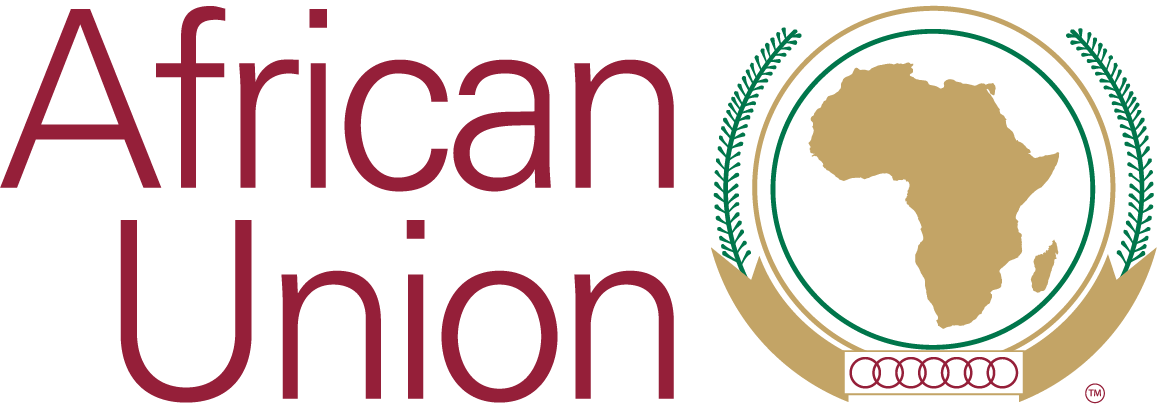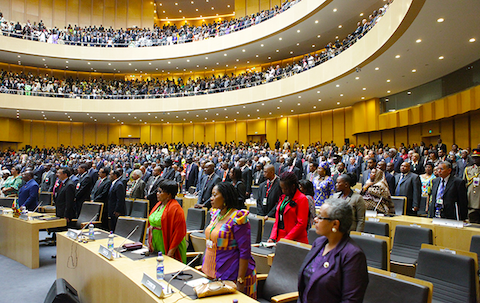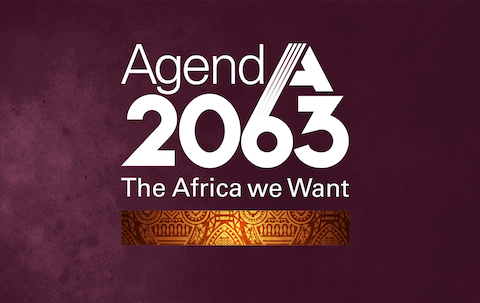لمحة تأريخية عن الإتحاد الأفريقي
منظمة الوحدة الأفريقية والإتحاد الأفريقي
في 25 مابو (أيار) 1963 في أديس أبابا، إثيوبيا، وافقت 32 دولة أفريقية حققت الإستقلال في ذلك الوقت لتأسيس منظمة الوحدة الأفريقية،. وانضم 21 عضوا تدريجيا لتصل إلى ما مجموعه 53 دولة منذ إنشاء الإتحاد الأفريقي في عام 2002. وفي 9 يوليو 2011، أصبح جنوب السودان العضو الرابع والخمسون في الاتحاد الأفريقي. الأهداف الرئيسية لمنظمة الوحدة الأفريقية، على النحو المنصوص عليه في ميثاق منظمة الوحدة الأفريقية، كانت لتعزيز الوحدة والتضامن بين الدول الأفريقية. تنسيق وتكثيف التعاون والجهود المبذولة لتحقيق حياة أفضل لشعوب أفريقيا؛ الحفاظ على السيادة والسلامة الإقليمية للدول الأعضاء؛ تخليص القارة من الاستعمار والتمييز العنصري؛ تعزيز التعاون الدولي في إطار الأمم المتحدة؛ ومواءمة سياسات الدول الأعضاء السياسية والدبلوماسية والاقتصادية والتعليمية والثقافية والصحية والرعاية الإجتماعية والعلمية والتقنية والدفاع.
تعمل منظمة الوحدة الأفريقية على أساس ميثاقها والمعاهدة المؤسسة للجماعة الإقتصادية الأفريقية (المعروفة باسم معاهدة أبوجا) عام 1991 وأجهزتها الرئيسية هي مؤتمر رؤساء الدول والحكومات، ومجلس الوزراء والأمانة العامة وكذلك لجنة الوساطة والتوفيق والتحكيم. اللجنة الاقتصادية والاجتماعية. لجنة الصحة للتربية والعلم والثقافة ولجنة الدفاع. تم استبدال لجنة الوساطة والتوفيق والتحكيم بآلية منع النزاعات وإدارتها وتسويتها في عام 1993.
الانتقال إلى الاتحاد الأفريقي:
خلال تسعينات القرن الماضي، ناقش القادة ضرورة تعديل هياكل منظمة الوحدة الأفريقية لتعكس تحديات عالم متغير. في عام 1999، أصدر رؤساء الدول والحكومات بمنظمة الوحدة الأفريقية إعلان سرت الذي يدعو إلى إنشاء اتحاد أفريقي جديد. كانت الرؤية للإتحاد بناء على عمل منظمة الوحدة الأفريقية من خلال إنشاء الهيئة التي يمكن أن تسرع بعملية التكامل في أفريقيا، ودعم وتمكين الدول الأفريقية في الإقتصاد العالمي ومعالجة المشاكل الإجتماعية والإقتصادية والسياسية المتعددة الجوانب التي تواجه القارة. في المجموع، تم عقد أربعة اجتماعات للقمة في الفترة التي تسبق الإطلاق الرسمي للاتحاد الأفريقي:
• قمة سرت (1999)، التي إعتمدت إعلان سرت والدعوة إلى إنشاء الاتحاد الأفريقي
• قمة لومي (2000)، التي اعتمدت القانون التأسيسي للإتحاد الأفريقي
• قمة لوساكا (2001)، التي صاغت خريطة الطريق لتنفيذ الإتحاد الافريقي
• قمة ديربان (2002)، التي أطلقت الإتحاد الأفريقي وعقد أول قمة لرؤساء الدول والحكومات.
تم دمج عدد كبير من هياكل منظمة الوحدة الأفريقية في اللإتحاد الأفريقي. وبالمثل، فإن العديد من الإلتزامات الأساسية لمنظمة الوحدة الأفريقية والقرارات والأطر الاستراتيجية إستمرت في صياغة سياسات الإتحاد الأفريقي. وبالرغم من أن البصمة لمنظمة الوحدة الأفريقية لا تزال قوية، أنشأ القانون التأسيسي للإتحاد الأفريقي والبروتوكولات عددا كبيرا من هياكل جديدة، سواء على مستوى الأجهزة الرئيسية أومن خلال مجموعة من اللجان الفنية والفرعية الجديدة تطورت العديد منها منذ عام 2002 وبعضها لا يزال قيد التطوير. اللغات بموجب المادة 11 من بروتوكول القانون التأسيسي للاتحاد الأفريقي، اللغات الرسمية للإتحاد الأفريقي وجميع مؤسساتها هي العربية والإنجليزية والفرنسية والبرتغالية والإسبانية والسواحيلية وأي لغة أفريقية أخرى. لغات العمل في الإتحاد الافريقي هي العربية والإنجليزية والفرنسية والبرتغالية.
رموز الإتحاد الأفريقي
يتألف شعار الإتحاد الأفريقي من أربعة عناصر. سعف النخيل على جانبي الدائرة برمز للسلام. الدائرة الذهبية ترمز للثروة والمستقبل المشرق لأفريقيا. خريطة أفريقيا بلا حدود في الدائرة الداخلية تعني الوحدة الأفريقية. والحلقات المتشابكة الحمراء الصغيرة عند قاعدة الشعار ترمز للتضامن الأفريقي والدماء التي سفكت من أجل تحرير أفريقيا.
اعتمد علم الاتحاد الأفريقي الحالي في يونيو 2010 في الدورة العادية الثانية عشرة لمؤتمر رؤساء الدول والحكومات. التصميم عبارة عن خريطة القارة الأفريقية باللون الأخضر الداكن فوق شمس باللون الأبيض، وتحيط بها دائرة من 54 نجمة خماسية الشكل وذهبية على خلفية حقل أخضر داكن اللون. الخلفية الخضراء ترمز إلى الأمل في أفريقيا، والنجوم تمثل الدول الأعضاء في الإتحاد الأفريقي.
The Organization of African Unity and the African Union
On May 25 1963 in Addis Ababa, Ethiopia, the 32 African states that had achieved independence at that time agreed to establish the Organization of African Unity (OAU). A further 21 members joined gradually, reaching a total of 53 by the time of the AU’s creation in 2002. On 9 July 2011, South Sudan became the 54th African Union (AU) member.
The OAU’s main objectives, as set out in the OAU Charter, were to promote the unity and solidarity of African states; coordinate and intensify their cooperation and efforts to achieve a better life for the peoples of Africa; safeguard the sovereignty and territorial integrity of Member States; rid the continent of colonisation and apartheid; promote international cooperation within the United Nations framework; and harmonise members’ political, diplomatic, economic, educational, cultural, health, welfare, scientific, technical and defence policies.
The OAU operated on the basis of its Charter and the 1991 Treaty Establishing the African Economic Community (known as the Abuja Treaty). Its major organs were the Assembly of Heads of State and Government, Council of Ministers and the General Secretariat as well as the Commission of Mediation, Conciliation and Arbitration; Economic and Social Commission; Educational, Scientific, Cultural and Health Commission; and Defence Commission. The Commission of Mediation, Conciliation and Arbitration was replaced by the Mechanism for Conflict Prevention, Management and Resolution in 1993.
Transition to the African Union
Through the 1990s, leaders debated the need to amend the OAU’s structures to reflect the challenges of a changing world. In 1999, the OAU Heads of State and Government issued the Sirte Declaration calling for the establishment of a new African Union. The vision for the Union was to build on the OAU’s work by establishing a body that could accelerate the process of integration in Africa, support the empowerment of African states in the global economy and address the multifaceted social, economic and political problems facing the continent. In total, four summits were held in the lead up to the official launching of the African Union, the:
• Sirte Summit (1999), which adopted the Sirte Declaration calling for the establishment of the AU
• Lomé Summit (2000), which adopted the AU Constitutive Act
• Lusaka Summit (2001), which drew the road map for implementation of the AU
• Durban Summit (2002), which launched the AU and convened its first Assembly of Heads of State and Government.
A significant number of OAU structures were carried forward into the AU. Similarly, many of the OAU’s core commitments, decisions and strategy frameworks continue to frame AU policies. However, while the footprint of the OAU is still strong, the AU Constitutive Act and protocols established a significant number of new structures, both at the level of major organs and through a range of new technical and subsidiary committees. Many of these have evolved since 2002 and some are still under development.
Languages
Under article 11 of the Protocol to the AU Constitutive Act, the official languages of the AU and all its institutions are Arabic, English, French, Portuguese, Spanish, Kiswahili and any other African language. The AU’s working languages are Arabic, English, French and Portuguese.
AU symbols
The AU emblem comprises four elements. The palm leaves shooting up on either side of the outer circle stand for peace. The gold circle symbolises Africa’s wealth and bright future. The plain map of Africa without boundaries in the inner circle signifies African unity. The small interlocking red rings at the base of the emblem stand for African solidarity and the blood shed for the liberation of Africa.
The current African Union flag was adopted in June 2010 at the Assembly of Heads of State and Government 12th ordinary session. The design is a dark-green map of the African continent on a white sun, surrounded by a circle of 53 five-pointed gold (yellow) stars, on a dark-green field. The green background symbolises the hope of Africa, and the stars represent Member States.
- Share:
- Français









